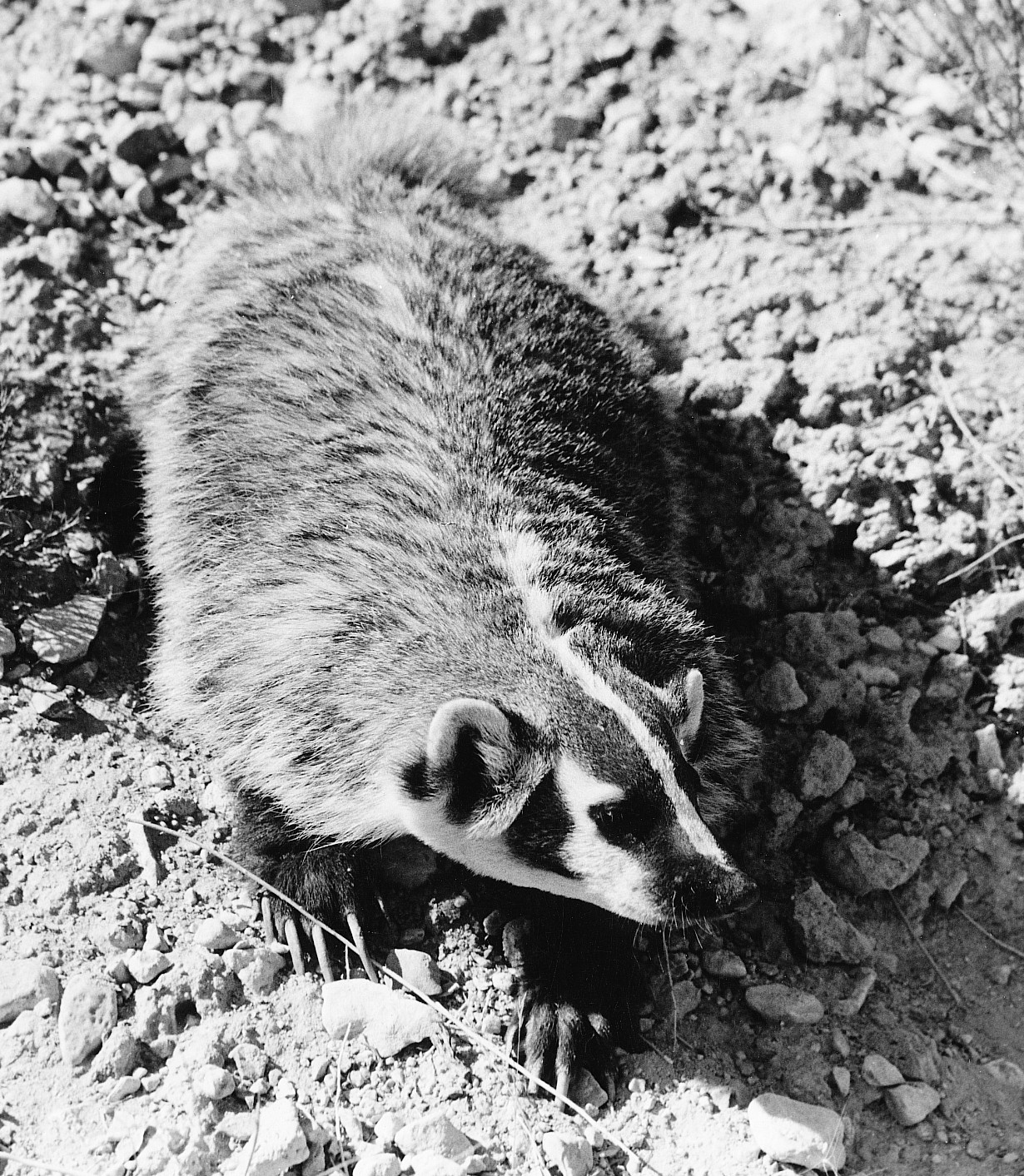AMERICAN BADGER
Taxidea taxus (Schreber 1777)
Order Carnivora : Family Mustelidae
DESCRIPTION. A rather large, robust, short-legged version of a weasel; body broad and squat; tail short, thick, and bushy, usually shorter than the outstretched hind legs; pelage long and shaggy, especially on back and sides; upperparts grizzled grayish yellow in color; a distinct white stripe from near tip of nose back over top of head to shoulder area, also a white crescent on each side of face just back of eye and another at anterior base of ear, enclosing or outlining a large blackish area; snout and rest of head grayish or blackish; underparts yellowish white; feet blackish; five toes on each foot; front feet large, with claws ≥25 mm in length; hind feet smaller, claws much shorter; skin loose on the body; eyes and ears small; neck short. Dental formula: I 3/3, C 1/1, Pm 3/3, M 1/2 × 2 = 34. Young similar to adults in color and color pattern. External measurements of an adult male: total length, 788 mm; tail, 133 mm; hind foot, 120 mm; of a female, 730-150-114 mm. Weight of adults, 4–10 kg, averaging about 7 kg.

DISTRIBUTION. Distributed throughout much of the state except for the extreme eastern part; may be extending its range eastward as a result of land-clearing operations and increased artificial grasslands.

SUBSPECIES. Taxidea t. berlandieri.
HABITS. American badgers occupy a variety of habitats. They are most common in the prairie and desert sections of the West, but limited numbers occur in the mountains, where individuals have been seen or captured at elevations well above 3,000 m. In general, they occupy the entire range inhabited by ground squirrels and prairie dogs, which they rely on for food. In Texas, they range from sea level, as on Padre Island, to at least 1,500 m (4,921 ft.) in the Davis Mountains.
As evidenced by the disproportionately long front claws, badgers are expert diggers, and their short, powerful front legs can move earth with amazing speed. A badger was encountered on Padre Island as it sought refuge in a shallow burrow in a sandbank. Three people, working frantically with shovels for more than an hour, were soon outdistanced in their attempt to capture the animal.
American badgers do not hibernate, but may sleep through several days of inclement weather, as do skunks and bears, subsisting on stored body fat. They do not experience the physiological changes characteristic of true hibernation (namely, considerably reduced rate of respiration and heartbeat, lowered body temperature, and insensibility). They are frequently seen in winter, particularly on mild days, and in the southern parts of their range they are active throughout the entire year.
The primary food of badgers is ground squirrels and other burrowing mammals such as pocket gophers, kangaroo rats, and cottontails. Badgers catch their prey by "digging out" the burrows, forcing the prey to the end of the burrow, where they are captured. They also eat lizards, birds, eggs, insects, and occasionally carrion.
Badgers are ordinarily solitary except during the mating season. They breed in summer and early autumn. Males are probably polygamous and mate with more than one female. Implantation is delayed until between December and February, and the young are not born until March or April. Litter size ranges from one to five, averaging about three. The young are born in an underground nest and are lightly furred and blind at birth. The eyes open at 4 weeks, and weaning occurs at about 8 weeks of age, when the young are half-grown. The young remain with their mother until late fall, when the family scatters.
Badgers have few natural predators other than humans. They are notoriously aggressive and are ferocious fighters. Typically, they are more than a match for dogs and large carnivores. In one recorded instance, a badger successfully defended itself in a fight with two coyotes.
The fur of the American badger ordinarily does not command a high price and, because of this, relatively few are trapped. In 2008–2009, fur buyers were not purchasing badger pelts. Data indicate that the population is now increasing except in those parts of the animal's range where poison is used, ostensibly to reduce the population of coyotes
POPULATION STATUS. Common. American badgers are locally abundant at many places in the state, and populations appear to be stable. They have been expanding their range and seem to be reasonably adaptable to human conditions, although land clearing and conversion and habitat fragmentation represent potential threats where development is accelerating.
CONSERVATION STATUS. The IUCN lists the American badger as a species of least concern, and it does not appear on the federal or state lists of concerned species. Reduction of the badger's primary food sources (prairie dogs and ground squirrels), due to increased agricultural land use, is a primary concern for this species. Careful monitoring would be prudent in the future.
From The Mammals of Texas, Seventh Edition by David J. Schmidly and Robert D. Bradley, copyright © 1994, 2004, 2016. Courtesy of the University of Texas Press.
Natural Science Research Laboratory
-
Address
Museum of Texas Tech University, 3301 4th street, Lubbock, TX 79409 -
Phone
806.742.2486 -
Email
nsrl.museum@ttu.edu

